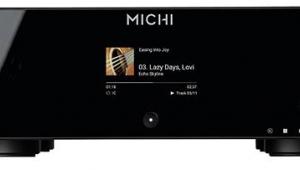Primaluna Prologue Eight (£1730)
But that would take millions of tubes!’ said a puzzled high-end distributor back in 1986, on first hearing that an American company had launched a valve CD player. He’d have been right, if anyone had really envisaged replacing all the player’s integrated circuits with glowing bottles.
It turned out, of course, that California Audio Labs had just added a tube analogue output stage, with gentle passive filtering, to an otherwise conventional player. The CAL Tempest was the first of more than few.
In 1998, a Dutch company called Ah! started rebuilding Marantz players with tube output stages and other mods under the brand name Njoe Tjoeb (‘New Tube’). The man behind Ah! was the Benelux countries’ most successful high-end importer, Herman van den Dungen. A couple of years later, with a team including ex-Goldmund electronics designer Marcel Croese, van den Dungen started planning his own range of valve products, which would be made in China to achieve affordable pricing, yet would be unusually desirable and ultra-reliable as well.
The result was the PrimaLuna ProLogue amplifier range, successfully launched in 2004, and now culminating in the ProLogue Eight CD player.
SIX INTO EIGHT
But van den Dungen wasn’t about to offer just another CD player with a couple of triodes tacked on the end of it. The ProLogue Eight has six valves on show, though admittedly the two big ones are rectifiers, not in the audio signal path. Inside, yet another valve is used in its master clock circuit in what PrimaLuna calls its SuperTubeClock.
Well-built and superbly finished, from its hefty aluminium front plate to the beautiful midnight-blue paintwork, the ProLogue Eight comes with a hefty metal system remote handset that makes it easy and pleasant to use. Our model also benefitted from a new I-to-V board upgrade (an extra £140). And so, after a few hours running in, I started using it.
SINGING IN THE RAIN
The very first track overthrew some prejudices. I happened to put on Jimmy & Wes: The Dynamic Duo [Verve 821 577-2], which really did set my feet tapping. Perhaps this is fanciful, but it seemed that the player gave a more than usually revealing view of the subtle amplifier distortions inherent in Montgomery’s fabulous, full-bodied guitar sound. For once those subtleties did not just disappear into the general losses and distortions of the system.
Moving from 1966 to 1989 and Jennifer Warnes Famous Blue Raincoat [Classic Records RTHCD 5052], I found the bass too soft, and not very extended. The mid was warm and inviting and the treble range smooth, but apparently rolled-off at the top. This time the result wasn’t as foot-tapping as it could have been. There was a loss of some fine detail, for example in the multitude of percussion sounds in ‘Bird On A Wire’.
Then again, Eric Bibb’s ‘Tall Cotton’, the great opening track on Diamond Days [Telarc CD 83660] showed just how likeable the PrimaLuna could be, even though the player didn’t seem to care much about tiny details, and those handclaps were almost indistinct. If the bass lacked definition, this hardly marred enjoyment of the track. Bibb’s voice was more honey-toned and persuasive than ever, and the lovely township guitar had a mellow ring and depth.
Turning to orchestral music, the 1959 RCA recording of Heifetz and the Boston Symphony under Munch playing the Mendelssohn violin concerto [JMCXR-0010 in JVC’s XRCD reissue series], the PrimaLuna had Heifetz sounding truly passionate, rather than just piercing. The boisterous orchestral sound was well conveyed too, with a good sense of space and placement. Here the PrimaLuna salvaged a recording that is just too overblown to be bearable on many a budget system.
On the other hand, on Beethoven’s 5th with Bernard Haitink and the LSO [LSO Live LSO 0590], it didn’t do so well. Any sense of space around the instruments was intermittent, and there was a feeling of compression as well as a thickened or congested quality on the climaxes. Instrumental timbres tended to flatten out into an blur, and the bass parts which should provide a foundation were too soft and muddy to do so.
Marta Gomez on Chesky [Entre Cada Palabra, JD301] seemed to show up the PrimaLuna’s strengths and its limitations. It was great on Marta’s voice, but it made the Chesky church sound like some huge cave, the rhythm instruments in that big acoustic becoming overpoweringly loose and muddled, so that it almost seemed as if Marta was struggling against them. Conversely, with the all-time classic of female vocal tracks, Rickie Lee Jones’ ‘Easy Money’, the singer was presented with tangible realism, everything stayed in proportion and the track bounced along.
HERE AND NOW
Maybe the PrimaLuna doesn’t actually sound great on every recording, but it is nearly always enjoyable. It produces impressive image depth, if not the greatest width, and it has that kind of alive, here-and-now valve-amp quality that can draw you in to the music.
If recent upsampling players give such a glossy, finely detailed sound that CD sounds like SACD, the PrimaLuna goes in a different direction. In both its strengths and its limitations, it really does sound more ‘analogue’.
It excels in bringing older recordings, seemingly killed in the transfer to CD, back to life. If you’ve recently found yourself blowing huge sums on audiophile vinyl, maybe you should try this player. It might make you start listening to CDs again.
VERDICT
You could guess that this player has been cleverly designed to produce a pleasing sound, rather than total accuracy. Its strengths are a lucid, unstressed and inviting midrange, with deep and well-populated stereo images. It shines particularly on analogue recordings, where its seemingly rolled-off treble and lack of bass precision aren’t usually serious issues. Ideal for the vinyl enthusiast.
Originally published in the November 2008 edition

























































